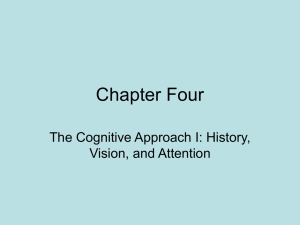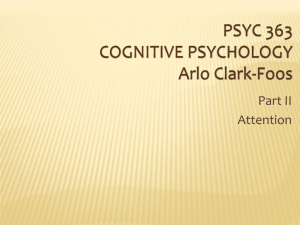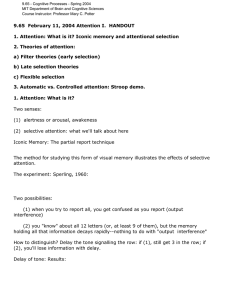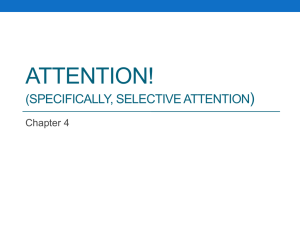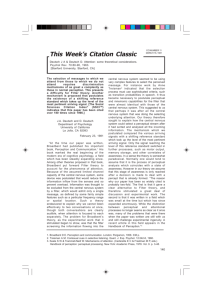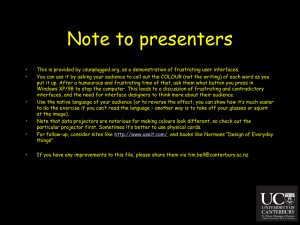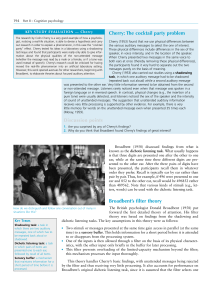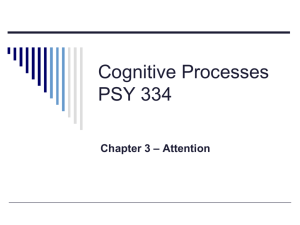Psych 335 Attention
advertisement
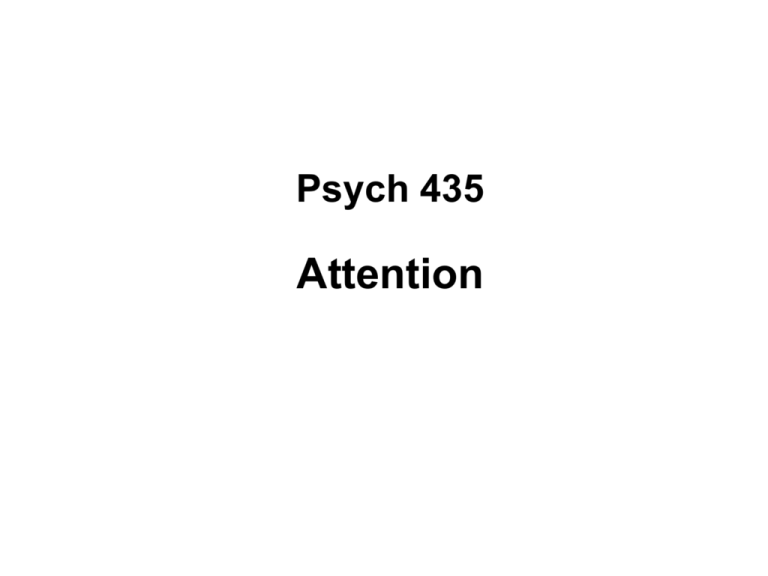
Psych 435 Attention Issues • Capacity – We can’t respond to everything in the environment – Too many pieces of information – we can only actively respond to a subset of these • Attention – The selection of relevant cues to respond to – Cues may be externally or internally generated Attention • What is attention? – “The concentration of mental effort on sensory or mental events” • Phenomena – – – – Switching vs. sharing attention Attention Capture Visual Search Selective attention- Stroop Examples of Controlled vs. Automatic Processes • Show 3 pairs of search demos • Each member of each pair will have a few or a lot of items • Search for a single target Find the T: L L L L T L L L • This was an automatic process: fast Find the T: L L L L L L L L T L L L L L L L L L L L L L L L L L L L L L L L L L • This was an automatic process: still fast even with more distractors Find the T: L T L L L L L • Slower without color Find the T: L L L L L L L L L L L L L L L L L L L L L L L T L L L L L L L L L L • This was a controlled search- slower, look at each letter • Much slower than with colored T Find the Red L T T L L T T L L T L • Slow: searching for a conjunction Find the Red L T L T L T L L L L LL TL L T L L T T T T L L T T L L L T L T L L T T L L L L L T L L T L T L T L L L L L T T • Even slower- searching for a conjunction Data from Display Set-Size Experiment Fast search done with automatic (preattentive) mechanisms Done in parallel Slow search done with controlled (attentive) mechanisms Done in serial Applications of Attentional Seach • List search situations and decide if fall into preattentive or attentive search requiring focal attention • E.g. – – – – Search computer screen for icon scan crowd for people scan crowd for americans look for airplane in sky • What makes things preattentive? – – – – probably the amount of difference between the objects L’s and T’s are similar Red and blue are quite different Looking for small differences requires focal attention Models of attention • Filter Models – Recognition after Filtering » Broadbent -or- – Recognition before Filtering » Broadbent’s critics • Attentuation Models – Treisman • Automatic vs. Controlled Processes – Also called Preattentive vs. Attentive Processes. – Neisser – Schneider and Shiffrin Filter Models • What is a Filter? • A description of the response properties of the system • Describes what a system responds to, and what it doesn’t respond to. Types of Filter Models Input Detection Recognition Recognition After Filtering (Broadbent): Filter Input Detection Recognition Recognition Before Filtering: Input Detection Recognition Filter Broadbent’s Filter Model • Channels carry different types of information • E.g. color, spatial frequency, pitch, hot, etc. • Apply mental effort: selectively process info coming from a small set of channels • We must do this: limited capacity processing and memory system – We just can’t deal with all the information at once • However, can switch between channels Broadbent’s Filter Model cont. • On the basis of some aspect of the stimulus or our memories, we can switch between channels • This switching may be voluntary or involuntary • Switching takes effort, reduces performance – Broadbent’s dichotic listening techinque- present two digits at once, one to each ear – 8, 3, 2 in left ear – 9, 1, 5 in right ear – recall by ear (left or right): subjects respond “8 3 2 9 1 5” – or in order: subjects respond “8 9 3 1 2 5” – performance for latter task is reduced (65% to 20%) – In second task subjects had to switch more often- hurts. Broadbent’s Filter Model cont. • Problems: Gray and Wedderburn (1960) – Easy to switch if information in the to-be-switched-to ear is relevant – e.g.: Story continues in alternating ears • Problems: GSR experiments – Associate word with shock- hearing word elicits a GSR response. – When that word is presented in unattended channel, produces GSR response. – Semantically similar words also elicit response- some semantic processing takes place in unattended channel. Attenuation Models-Treisman • Info in unattended channels is still processed – but at a reduced rate – info in unattended channels is attenuated. Treisman’s Attention Model Attention Capture Failures of Selective Attention • Attention is supposed to focus in on what you want to attend to • Exclude irrelevant information Stroop Task Blue Yellow Red Green Green Yellow Green Yellow Yellow Green Blue Blue Red Blue Red Green Stroop Task ***** ***** ***** ***** ***** ***** ***** ***** ***** ***** ***** ***** ***** ***** ***** ***** Stroop Task Blue Yellow Red Green Green Yellow Green Yellow Yellow Green Blue Blue Red Green Blue Red Stroop Task Yellow Green Blue Yellow Blue Blue Red Green Red Red Yellow Red Blue Yellow Blue Blue Stroop • Failure of selective attention • Race model – Word name is processed automatically – Color is not so automatic – Both arrive at the same time, we have a hard time attending to the relevant stimulus attribute – Doesn’t happen upside down e ul B woll e Y de R neer G neer G woll e Y neer G woll e Y woll e Y neer G de R e ul B e ul B e ul B de R neer G . Stroop Task Failure of Attention: Failure to Disengage • Mind Develops Brain clip – infant- failure to disengage Spatial Attention: Posner Task Fixation Point T i m e Cue 75% accurate Attention switches to here (but eyes don’t move) or here: Target might appear here: A A Sharing Attention: Dual Tasks • Do two things at once: can they be performed at the same time? • Do they interfere? • Experiment has 3 conditions • Task A alone • Task B alone • Task A and B together at the same time Sharing Attention: Dual Tasks • • • • Example: Pat head and rub belly Now speed up just your belly If you can’t do it, it suggest that they share the same processing capacity • Same brain area? Sharing Attention: Dual Tasks Example: Task A: Driving without an accident Task B: Talking on cell phone Can you talk on your cell phone at the normal rate while still driving without getting into an accident? Normal Save Driving Speed: 30 mph Normal speaking rate: 80 wpm 40 c 30 Safe Driving Speed a b 20 10 0 0 50 100 words per minute Central Executive Interactions Pet Evidence-Right Parietal Lesion Data- Attending to Different Spatial Scales
